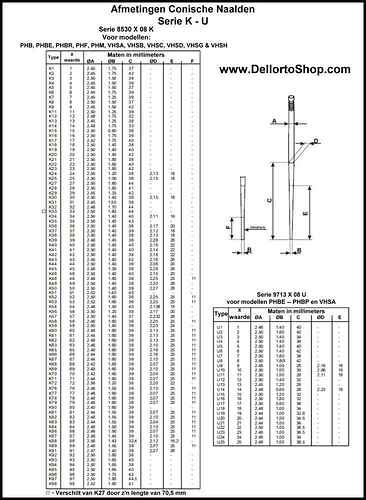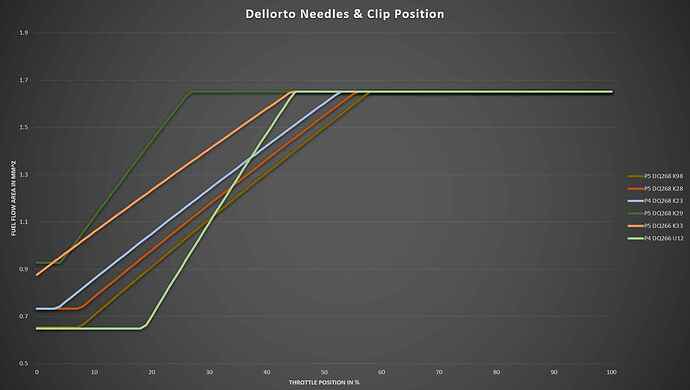Ooooh fun. U12 looks like a bizarre needle for sure. The U-series is shorter in length than the K-series correct? Do you recall the length difference, and whether U12 is a 4-position or 5-position needle?
U12 is indeed 4 positions !
I haven’t exactly measured the difference between a standard K98 and a U12, but it is considerably shorter. Some values here
I was able to locate somewhere that U-type needles are 68mm (5.5mm shorter than K-type), so let’s assume that’s correct for now.
I took the time to add this to my needle graph to see how it compares to some “conventional” combos, along with the K33 (~3mm shorter than standard, but with same length taper as K27), and K29 as a total outlier. Very aggressive delivery on the U12, which makes sense given the short taper length.
This is with a 145 main jet:
So awesome, thanks for the simulation.
Would the fact that I use a 60 slide ( which further leans out the mixture, especially at 1/4 to 1/2 throttle) have an impact in the data ? How about if you lower the main jet to 135? I have found the pickup to be much crisper with the 60 slide, without any apparent detonation under normal circumstances.
Here is another “far out” needle that I have grown particularly fond of, especially for longer circuits:
50 slide
K6 (three position needle)
3rd position
158 main
DQ263
B52 inner / 60 oute
Egt
620 high
425 low @ 18 degrees Celsius, on 98 pump gas.
Feel free to run a sim on this too ![]()
My model is pretty rudimentary in that it only captures fuel flow area between the atomizer and the conical needle. I added a mechanical constraint for the main jet size based on input from @Andy_DiGiusto a while back. So it doesn’t capture many other important factors within the VHSH 30. The original goal with this was just get a visual representation of what different needles do, since there’s obviously a big difference, but the Dellorto chart isn’t terribly insightful to me without taking it a few steps further.
I’ll have to map that other needle you mentioned and report back.
Here’s an updated graph with K6 P3 included (red line), a couple of the big outliers removed, and main jet changed to 158. It’s funny and I’m sure there are other more complicated factors at play here, but from a fuel flow area standpoint your combo with the K6 is basically the same as a K22 DQ268 at P2.5 - P3 ![]() …would be cool to test those combos on track and see how they compare in real life.
…would be cool to test those combos on track and see how they compare in real life.
The K6 is also pretty close in profile to the K16, which I’ve used a number of times and liked.
Very nice, thanks again.
The K33 (in terms of graphical representation at least) seems to be the theoretical best, but i’ve never seen it irl.
Have you ever used it? The linearity of the delivery seems optimal, at least theoretically…
That U12 is very interesting. Very lean on the bottom and richens quickly. Might be able to get away with richer pilot jets with that needle. ![]()
Correct, i originally began with the usual B45 but found that not enough fuel was being provided at closed throttle. Very high low temps and the piston was detonating rather quickly. I kept on moving upwards until the temps stabilized around 470 - 480 Celsius, which (at least with our fuel) was with a B65.
As stated before, the 60 slide allowed me to maintain very good reactivity with relatively little impact on the leanness of the mixture at closed or partially opened throttle.
I have found this needle to work particularly well in circuits with a relatively high amount of “Stop - Go” corners, which favor quick pickup.
Regarding the K33, it’s all dependent on atmospheric conditions (no surprise). The amount of fuel it delivers is actually a huge jump compared to the others represented here. I have one in my jet kit, but it’s too rich for like 99% of conditions I run in.
I can echo your findings about the more aggressive needles being better suited to stop/go tracks. I’ve found that with more sweeping tracks that require more modulation (GoPro Motorplex for example) I’ve preferred shorter tapers so it doesn’t dump as much fuel as early.
In general, the needles with smaller tips will allow you to run a leaner main jet vs those with the 1.8mm tip, sometime 6-8 sizes leaner depending on the needle & atomizer. I’ve seen theories on why this is the case, but it’s a bit over my head. The near infinite adjustability of the VHSH 30 is part of what makes it so great, but it’s also easy to get lost in the sauce. I’ve won plenty of races on just plain old K98/DQ268 ![]()
As I side note, I’m curious why you have different EGT targets for the two carb setups you mentioned. Are other factors equal with the engine itself (squish, timing, piston type, etc)? You mentioned one setup being preferred for long track. Would that account for part of the difference with the EGT’s?
TBH with you, K98 / DQ268 is literally what i almost exclusively run during normal practice days, which are not meant to prepare for a race ![]() . I prefer to focus on myself and my driving more than anything.
. I prefer to focus on myself and my driving more than anything.
The way i approach it is i usually begin carburation work in practice days roughly a week prior an event, which begins to mirror a (usually) representative track and atmospheric conditions.
Regarding the EGT values and their differences amongst the two setups, i wouldn’t necessarily read toooo much into them (i do confirm they were utilized on the same engine with all other variables you have listed controlled). It was more to give users that may be interested to try them some expected values.
To me, i utilize EGT values for different setups as a behavioral trend rather than absolute values, as they can vary so much with atmospheric conditions (which in themselves can also vary within a singular 10 min run…)
For instance, i know that no matter what i do (short of bogging the thing down), the U12 will always run hotter on min temps vs K needles without detonating.
Now, i cannot tell you exactly why that is the case and why it doesn’t lead to detonation with this specific setup, but i can guarantee i will detonate @480 min EGT with a K98.
In regards to short vs long circuits, i personally eer towards attempting to cool the cylinder and piston down upon throttle closure, when it is under extensive WOT operation (long circuits), especially in race conditions and a race carburation. This is why i have a preference to use a needle which is relatively rich in the low RPMs for these occasions, as i have seen many mid-rpm seizures right under acceleration after an extensive WOT section… Conversely, this is not that much of an issue on shorter tighter tracks.
(also lets be honest, getting lost in the sauce with 583 different needles and 304 different little tubes that deliver fuel is the best thing that there is)
This topic is making me part miss KZ and also reminding me of the “fun” of carb tuning when it’s not running the way I want it to.
Same. I might as well bathe in the sauce lol…for me the process is half the fun, as evidenced by the ridiculous spreadsheet I built ![]()
Fun fact, after adding the K6 needle to my model, I learned that Excel has a maximum number of series it will graph, and that number is 255 ![]()
![]()
![]() Between various needles/atomizers/clip positions that data set has over 26,000 cells
Between various needles/atomizers/clip positions that data set has over 26,000 cells ![]()
In my experience/understanding this is simply because you can change the size of main jet, emulsion tube, and needle, and achieve the same annulus size of which the fuel is actually flowing through.
For example, if you changed from a 1.6 mm tip needle, to a 1.8 mm tip, you could then change from a main jet pinned at 1.5 mm (Which, should be marked 150, but uh, isn’t.) to a main jet pinned at 1.7 mm, and maintain the same flow area.
It’s not quite that simple, but if you’re changing needles, and want to be safe when going to a larger needle tip, it can alleviate some anxiety. No one likes ending their day early with Mardi-Gras head.
It’s beyond my comprehension really, so I just validate with on-track testing ![]()
To me the importance of annulus makes no sense on paper, as the needle (assuming K-type) is never raised high enough to where the minimum flow area is actually at the tip of the needle. In other words there is usually a constraint above the tip where the top of the tube actually meets the needle.
Couple that with another constraint (usually) at the main jet, which is obviously below the needle, and the theory turns into a bit of a head scratcher for me.
Listen to everyone.
Believe no one.
Test Everything.
![]()





